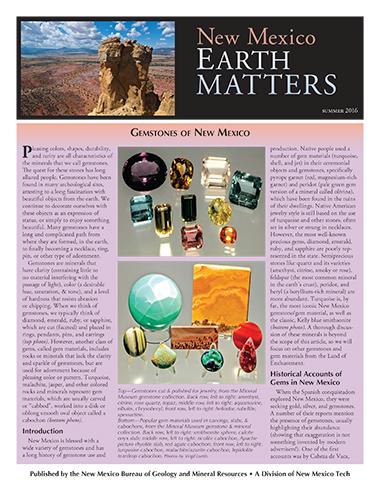
New Mexico Earth Matters — Back-issues

Vol. 16, No. 2, Summer 2016 934 KB
Gemstones of New Mexico
— Kelsey McNamara and Virgil Lueth
— Kelsey McNamara and Virgil Lueth
Pleasing colors, shapes, durability, and rarity are all characteristics of the minerals that we call gemstones. The quest for these stones has long allured people. Gemstones have been found in many archeological sites, attesting to a long fascination with beautiful objects from the earth. We continue to decorate ourselves with these objects as an expression of status, or simply to enjoy something beautiful. Many gemstones have a long and complicated path from where they are formed, in the earth, to finally becoming a necklace, ring, pin, or other type of adornment. Gemstones are minerals that have clarity (containing little to no material interfering with the passage of light), color (a desirable hue, saturation, & tone), and a level of hardness that resists abrasion or chipping. When we think of gemstones, we typically think of diamond, emerald, ruby, or sapphire, which are cut (faceted) and placed in rings, pendants, pins, and earrings (top photo). However, another class of gems, called gem materials, includes rocks or minerals that lack the clarity and sparkle of gemstones, but are used for adornment because of pleasing color or pattern. Turquoise, malachite, jasper, and other colored rocks and minerals represent gem materials, which are usually carved or “cabbed”, worked into a disk or oblong smooth oval object called a cabochon.


